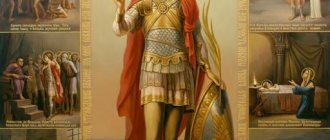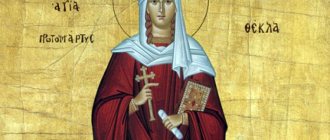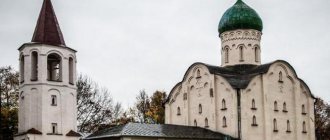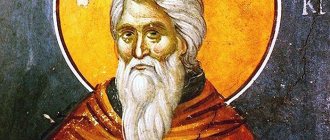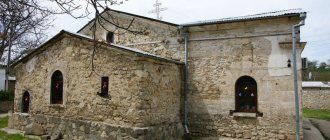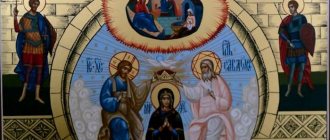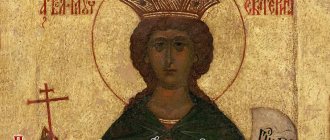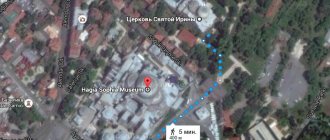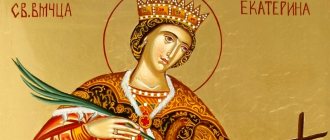Brief biography of the saint
The martyrdom and miracles of Euphemia the All-Praised are known from the description of Simeon Metaphrast, the anonymous “Martyrdom” and “Words on the Suffering of the Great Martyr. Euphemia" of the holy metropolitan Amasia of Pontus, Austeria.
Origin
The Great Martyr Euphemia was born in 304 in the city of Chalcedon, province of Europe, in Byzantium. The girl came from a noble family. The saint's parents are Senator Felafron and Theodosia.
Life and service to God
The proconsul of the province, Priscus, came up with a ruse to reveal the secret Christians. An ardent idolater called on residents to come to the festival of the war god Ares and make a sacrifice. During the celebration, warriors went around the city and arrested residents who did not go to the sacrifice. Disobedient townspeople faced torture and death unless they confessed to apostasy and returned to faith in the pagan gods.
Strength of will
In one house the guards found 50 Christians. While the pagans praised the god of war, they prayed to the One God. The senator's daughter Euphemia also came to the service. She and all the participants in the service were taken to the proconsul, interrogated and tortured. After 19 days, no one has repented.
Priscus directed his thoughts towards young Euphemia. The proconsul decided that the conversion of the noble girl would shake the convictions of the remaining apostates. According to his plan, loneliness and fear were supposed to break the girl. Therefore, Priscus ordered her to be tortured alone.
The power of faith
Euphemia was tied to a torture wheel with blades, which rotated and caused suffering. The girl prayed fervently, and the gun stopped. The servants were unable to restart the mechanism. An angel appeared to the prisoner and healed her wounds. The guards Victor and Sosthenes saw the miracle.
Saving Euphemia angered Priscus. He ordered Victor and Sosthenes to throw the great martyr into the oven. Now the guards saw two angels looking at them from the flames. The soldiers refused to obey and declared themselves Christians. By order of the proconsul, they were locked in the arena and the animals were released. Victor and Sosthenes offered up prayers to God, and their souls ascended to heaven before the teeth and claws of animals touched their bodies.
The trial by fire continued for Euphemia. The faithful pagans carried out the order of the proconsul and threw the girl into the oven. She came out unharmed. Priscus ordered the great martyr to be taken to prison, and he himself began to think. He explained the girl’s invulnerability by conspiracy or witchcraft.
To convict Euphemia of either one or the other, the proconsul prepared a trap. On his orders, they dug a ditch, stuck knives at the bottom with the blades up and covered them with branches. Priscus forced Euphemia to walk along the ditch, keeping silent about the knives. The Great Martyr walked as if on solid ground.
The last test awaited Euphemia in the arena with wild animals. The Great Martyr prayed to the Lord to take her to heaven. The animals did not touch her. Only the bear scratched her leg and drew blood so that Euphemia’s request would be fulfilled. The girl's soul flew away, and the city was shaken by an earthquake.
Miracles
Parents buried Euphemia outside the city. A temple was built next to the grave of the great martyr, in which the relics of the saint were placed. In 451, the IV Ecumenical Council was held in the Church of Euphemia the All-Praised, dedicated to the issue of the dual nature of Jesus Christ. At that time, the heretical teaching of the Monophysites began to spread, who recognized the Savior only as God. The original dogma, supported by Orthodoxy, spoke of the union of the Divine and human natures of Christ.
The discussion led representatives of Orthodoxy and Monophysitism to a dead end. The Patriarch of Constantinople, Anatoly, suggested asking for help from the Holy Spirit and the Great Martyr Euphemia. The Council participants prepared two scrolls: an Orthodox one, outlining the orthodox teaching, and a Monophysite one, with a denial of Jesus the man.
Emperor Marcian arrived for an official examination. The ministers opened the shrine of Saint Euphemia. The documents were placed on the chest of the great martyr. The emperor sealed the sarcophagus and assigned guards.
The patriarchs prayed and fasted for three days. On the fourth day, the meeting participants again came to the temple. They saw the first evidence of the expression of the will of the Holy Spirit when they opened the shrine. The scroll with Orthodox teachings was in the right hand of the great martyr, and the document of the Monophysites was at her feet.
Saint Euphemia herself confirmed the truth of the Christian faith and extended her right hand with a scroll to the participants of the meeting. The miraculous phenomenon strengthened Christians and many heretics in the true faith. Convinced Monophysites were excommunicated from the church.
Life and martyrdom
Senator Philofron and his wife Theodosia, who lived in Chalcedon at the end of the third century, converted to Christianity and raised their children in the glorification of the living God, Jesus Christ. Their daughter Euphemia was a particularly zealous Christian, about whose life before the period of the appearance of the feat of fidelity to the Savior, nothing is known.
Great Martyr Euphemia of All Praise, Chalcedonian
Emperor Diocletian was known as an ardent supporter of paganism and encouraged the persecution of Christians. The Chalcedonian ruler Priscus fully supported the emperor's policies and took all measures to destroy the smallest manifestation of Christianity in the area.
In order to identify fans of Christianity among the population, Priscus organizes a holiday in honor of the pagan idol Ares, and, under pain of death, orders all residents of the Chalcedonian district to appear and make sacrifices in front of the idol temple.
Read about persecution:
- Persecution of Christians
- Russian Orthodox Church during the period of persecution
During the holiday, 50 worshipers of the living God secretly gathered to worship and glorify Jesus Christ, among them was the young maiden Euphemia.
Ruler Priscus was informed about the secret meetings of Christians, he ordered everyone to be arrested. For 19 days, with terrible torture, the pagans tried to force the faithful worshipers of God to renounce their faith, but they were unable to cope, and sent 49 people to trial before the emperor, leaving the girl behind. The executioners hoped that without the support of her comrades the girl would break, but they had to bitterly regret their decision.
The history of the discovery of the relics of the VMC and their veneration
In the records of the church historian Eugarius Scholasticus there is a description of the miracles that took place at the relics of the Great Martyr Euphemia in the Chalcedonian temple. The remains exuded blood, which was collected with a stick with a sponge at the end through a hole in the cancer. The saint appeared in a dream to pious townspeople and invited them to come to the temple to collect sacred gifts. The servants poured the collected liquid into flasks and distributed them to people.
Emperor Mauritius doubted the authenticity of the life-giving blood of the great martyr and wanted to take a sample for research. But a miracle happened - the relics of Euphemia released a lot of liquid, and the temple was filled with a divine fragrance. The emperor repented of his unbelief.
The remains of the Great Martyr Euphemia were in Constantinople. They were transported to the Orthodox monastery in 620 to protect them from destruction during the outbreak of war with the Persians. The relics were kept in a church consecrated in honor of the great martyr.
In the 8th century, a new heresy, supported by Emperor Leo the Isaurian, spread - the denial of icons and relics as repositories of the Holy Spirit. The sacred shrine containing the relics of the Great Martyr Euphemia was thrown into the waters of the Bosphorus by order of the emperor. The sarcophagus was lifted on board by the sailors of the ship, which headed for the island of Lemnos.
The relics were first kept secret, and then the local bishop built a church in the name of St. Euphemia. The sarcophagus stood in the temple until, at the end of the 8th century, the new Patriarch, Tarasius, stopped heresy and the destruction of shrines. Subsequently, the relics of the Great Martyr Euphemia were returned to Constantinople. The shrine rests in the city of Phanar, in the Cathedral of St. George.
If you ask in faith
Euphemia the All-Praised was revered in Chalcedon, where she lived. The temple with her relics stood in the same place where the saint was buried by her parents after her death in the arena of the Roman circus. In the marble tomb there was an ark with relics, and on the side there was a small hole. Every year on the day when she suffered for Christ, it was opened after the All-Night Vigil, and the bishop took out from there a previously dry sponge, soaked in holy blood. It smelled fragrant and healed any disease. There are numerous cases where the saint helped the sick, even in Russia. For some reason, it is generally accepted that each saint has his own “specialization.” But in fact, they, who live in the glory of God, can beg any mercy from him for us if they ask with faith. The miraculous icon was found in one of the Russian villages in July 1910. People who prayed to her were relieved of toothache and blindness; she saved the village and surrounding area from dysentery, which at that time threatened death, and was often its cause. The drought caused local residents to demand that a well be dug at the site where the icon was found. One of the peasants saw a dream about the need for this. And only after the requirement was fulfilled did the weather improve.
Appearance to Paisius the Holy Mountain
In 1974, the famous associate Father Paisius lived on Mount Athos in the kaliva of the Holy Cross. He rarely went to the city, but an intractable church issue forced him to leave his cell. Upon his return, Father Paisiy was still upset.
The monk read the clock in his cell. Suddenly there was a knock on the door. To the question “who is there?”, a female voice answered “Euphemia”. Paisius was surprised where the woman appeared on Mount Athos. In order not to succumb to the machinations of the evil one, who often fooled the Athonite monks, Paisius did not open it. The woman knocked again and introduced herself as Euphemia. The second time the holy father did not open it to her. For the third time, the door of the cell opened on its own, despite the closed bolt.
Paisius saw a woman illuminated by light. The Apostle Luke stood next to her, as it seemed to the elder, but then he disappeared. Paisius felt the grace emanating from the woman, but decided to test it and called on them to pray together to the Holy Trinity. Euphemia repeated the words of the prayer after Paisius.
Having made sure after the prayer that before him was the Great Martyr Euphemia the All-Praised from ancient Chalcedon, Paisius seated the guest in her cell, and they had a conversation. The saint helped resolve the church issue that was tormenting the monk, and also spoke about her torment in the name of Christ.
Father Paisiy was surprised how such a small and weak woman survived the torture. The torture that befell the unfortunate woman seemed monstrous to him. But Euphemia replied that for the difficult trials the martyrs were entitled to grace in heaven. The saint came to resolve the issue of the church, as at the Ecumenical Council, and not to honor the elder with her presence. After Euphemia’s visit, Paisius was in a joyful mood and for three days he could only praise God. He wrote laudatory stichera in honor of the great martyr.
During his next trip to the city, Paisius met with the nuns of the monastery in Suroti and told them about the miracle. Based on the elder’s description, the sisters painted an icon of St. Euphemia. Paisius himself made wooden icons of the great martyr and distributed them to pilgrims. When making the steel matrix, he was unable to beautifully carve Euphemia’s left hand. In unsuccessful attempts, Paisius saw retribution for testing the saint “against the evil one.”
When is the day of remembrance of the Great Martyr Euphemia All-Praised in 2022?
The Day of Remembrance of Euphemia the All-Praised will be celebrated twice in 2022.
- September 29
is the day of memory of Euphemia the All-Praised. - July 24
- memories of the miracle of Euphemia the All-Praised.
According to the old style, the day of memory of Euphemia the All-Praised was celebrated on the church calendar on September 16. The day of remembrance of the miracle of Euphemia the All-Praised is celebrated on the church calendar according to the old style - July 11. The dates are not moving; they are celebrated by the Orthodox Church on the same day every year.
Iconography
In early Byzantine wall paintings, Euphemia was depicted as a young girl in rich clothes, with a martyr's crown on her head and a palm branch in her hand. On frescoes of the 10th century in churches in Italy, Greece, and Macedonia, the great martyr appears dressed in a dark maforia. The saint holds a scroll, a cross, or extends her palms forward, receiving grace.
Icons of Saint Euphemia are rare. The first known icon depicting the sufferings of the great martyr was kept in her temple near Chalcedon. In the illustration in the London version of Theodore's Psalter, Euphemia is surrounded by wild animals. Also in minologies they depict a miracle at the Ecumenical Council.
Attributes of the Great Martyr in Western iconography:
- lily;
- cloak;
- diadem;
- Palm branch;
- sword;
- staff.
A lion was depicted at Euphemia’s feet. Old Russian icon painters followed the Byzantine tradition of depicting the saint. Sometimes her head was covered with a white scarf.
Historical background
Euphemia's name and year of death are recorded in the 5th century. Martyrology Hieronymianum
, the earliest surviving list of Christian martyrs.
The year 303 was the first year of the Great Persecution under the Roman Emperor Diocletian. The Fasti vindobonenses
, a collection of liturgical documents from the 4th-6th centuries, says that she died on 16 October. Apart from this, there is no reliable historical information about Euphemia.[1]Egeria, who made a pilgrimage to the Holy Land around 381–384 and wrote an account of her travels, says that she was shown the site of Euphemia's martyrdom at Chalcedon.[1] Euphemia became a famous saint, and stories about her accumulated; then the Golden Legend, a collection of hagiography from about 1260, includes the story of her martyrdom.[1]
Prayer text
Oh, holy, all-praised Euthymia, immaculate virgin and glorious great martyr, true bride of Christ, given to us for protection by the Lord, hear now our prayers offered to you with love. By the grace given to you from God, help us, the weak and wretched, to pass fearlessly through the field of this much-difficult and much-sorrowful life, so that we may, like you, not be afraid of the machinations of the evil enemy, who are being raised against us and who want to destroy our souls. Bring our humble prayer to our Sweetest Lord Jesus Christ and beg Him to grant us strength and strength, patience and humility, so that with them we may overcome the enemy and tirelessly glorify our Lord, with Him the Heavenly Father and the Holy Spirit, now and ever and unto the ages of ages. . Amen.
Death in the name of the Lord
Priscus came up with many tortures for the captive, whom he considered a sorceress. It was never possible to break her, and all the torture did not harm her. The saw with which they wanted to saw her became dull, the snakes in the ditch where they threw her did not bite, but carried her to the shore. Then they took the martyr to the circus to put her to death as usual for Christians, to be torn to pieces by wild beasts. In prayer, she asked God to accept her sacrifice and rest her soul in the villages of martyrs and saints. Lions and bears released into the arena licked the feet of the one they were about to tear apart. Only one small wound was bleeding on her body. Finally, the Almighty condescended to pray, and she died, proving with her life “the weakness of demons and the madness of the tormentor.” An earthquake began immediately. Pagan temples and fortress walls collapsed, burying the wicked. Everyone fled, and the parents took their daughter and buried her near the city. It was on that spot that the first temple was subsequently erected in honor of the saint.
